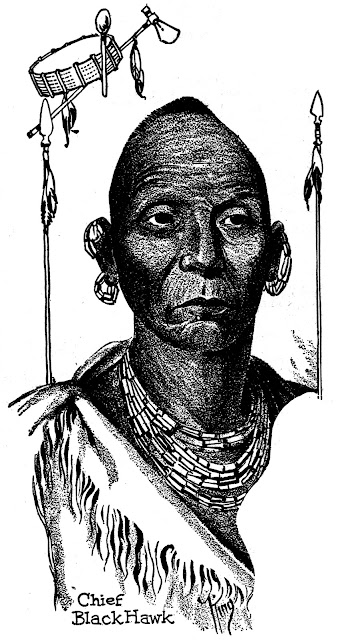This c. 1835 portrait of Black Hawk by George Catlin hangs in the National Portrait Gallery in Washington, DC.
"The push westward, led by scouts like Daniel Boone or Davy Crockett and followed by settlers moving across the Appalachians, ran up against organized Indian resistance. By 1804, the Sac people had ceded their land to the government, but Black Hawk stirred his tribe to reclaim its territory. He led a long resistance to the United States, from fighting in the War of 1812, when he sided with the British, to his instigation of what is known as the Black Hawk War in 1832. Black Hawk brought on the conflict as a last-ditch effort to resist President Jackson's aggressive policy of Indian removal. He said, 'the cause of our making war ... is known to all white men. They ought to be ashamed of it.' After a campaign of five months, Black Hawk was defeated at the Battle of Bad Axe." -- National Portrait Gallery
McClure's Magazine in 1896 published a photo of Catlin's painting along with a lengthy caption in a series about Abraham Lincoln edited by Ida Tarbell (McClure's Magazine Vol. 6 No 2 January 1896 Page 123).
After a portrait by George Catlin, in the National Museum at Washington, D. C. and here reproduced by the courtesy of the director, Mr. G. Brown Goode. Makataimeshekiakiak, the Black Hawk Sparrow, was born in 1767 on the Rock River. He was not a chief by birth, but through the valor of his deeds became the leader of his village. He was imaginative and discontented, and bred endless trouble in the Northwest by his complaints and his visionary schemes. He was completely under the influence of the British agents, and in 1812 joined Tecumseh in the war against the United States. After the close of that war, the Hawk was peaceable until driven to resistance by the encroachments of the squatters. After the battle of Bad Axe he escaped, and was not captured until betrayed by two Winnebagoes. He was taken to Fort Armstrong, where he signed a treaty of peace, and then was transferred as a prisoner of war to Jefferson Barracks, now St. Louis, where Catlin painted him. Catlin, in his “Eight Years,” says : “When I painted this chief, he was dressed in a plain suit of buckskin, with a string of wampum in his ears and on his neck, and held in his hand his medicine-bag, which was the skin of a black hawk, from which he had taken his name, and the tail of which made him a fan, which he was almost constantly using.” In April, 1833, Black Hawk and the other prisoners of war were transferred to Fortress Monroe. They were released in June, and made a trip through the Atlantic cities before returning West. Black Hawk settled in Iowa, where he and his followers were given a small reservation in Davis County. He died in 1838.
The Library of Congress has this engraving of Black Hawk based on a painting taken from life in 1833.
Mac-cut-i-mish-e-ca-cu-cac or Black Hawk, a Celebrated Sac chief,
painted from life by J. O. Lewis at Detroit 1833
Lehman & Duval lithrs. c1836.





No comments:
Post a Comment